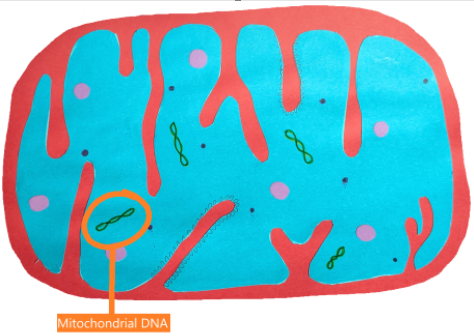Leigh Syndrome is a severe neurological condition that affects the mitochondria. It affects one in four thousand people, but that ratio depends on the region. It causes debilitating symptoms like loss of motor control, developmental difficulties, seizures, and more. It is usually diagnosed when the patient is still an infant, but symptoms can appear later in life. When symptoms start appearing, they only have about one or two years left of their life. Leigh Syndrome is a progressive disease, which means that it gets worse as time goes on.
Leigh Syndrome is a disease in which genes are mutated. Patient’s can inherit Leigh Syndrome a couple different ways. One way is by mitochondrial DNA. Mitochondrial DNA is inherited only from the mother. The other way is through mutations in nuclear DNA. Nuclear DNA can be inherited from mother or father. Mutations with mitochondrial DNA are generally more severe than nuclear DNA.
There are three different stages of Leigh Syndrome. Those stages are: early-onset, late-onset, and Leigh-like syndrome. Early-onset is diagnosed before the child is two years old, and is definitively fatal. Late-onset is more rare, but still occurs. It is diagnosed in adolescence or adulthood, and has a higher likelihood for survival. Leigh-like syndrome is when all of the symptoms for regular Leigh Syndrome are present, but screenings do not pick up on it. This stage can progress into more severe symptoms as well.
In the UK, there is a girl, Emily, that was diagnosed with Leigh Syndrome at the age of two. This diagnosis would be considered late-onset. Late-onset Leigh Syndrome is generally more survivable, early-onset is fatal. When testing for Leigh Syndrome, they look for symptoms like feeding problems, excessive crying, and seizures in infants. The doctors told her parents that she would not survive, that the disease is fatal. In one to two years, the disease progresses so far that it causes respiratory failure. This is the main cause of death for people with Leigh Syndrome. Each breath she takes is a miracle, considering that she is now sixteen years old. Though she has Leigh Syndrome, she is still living and breathing. This is incredibly rare, and the mental stress of having this disease must be incredible.
People suffering with Leigh Syndrome need to be constantly monitored. Leigh Syndrome is extremely dangerous, like having a bomb strapped to your chest, but the bomb is your entire nervous system. Patients may go through periods of time where symptoms worsen, like blackouts, incoherency, and loss of muscle control. At least annually, many tests need to be performed to ensure the safety of the individual.
Currently, there is no cure for Leigh Syndrome. People with Leigh Syndrome may do some treatments to help with discomfort from the disease, but it will not cure it. People who presented symptoms later in life could switch to a different diet. The benefit of this is to give the brain a separate resource for energy, but of course it does not solve the root issue. Breathing supplements may help with lung issues that may arise, along with seizure and involuntary movement medications. There is mental health support for the families involved in the patient’s life, like therapy and medication. I hope that people affected by Leigh Syndrome get as much help as they can, and that the families affected can grieve their losses properly.

“Leigh Syndrome: Medlineplus Genetics.” MedlinePlus, U.S. National Library of Medicine, medlineplus.gov/genetics/condition/leigh-syndrome/#:~:text=Severe%20muscle%20and%20movement%20problems,movement%20and%20balance%20(ataxia). Accessed 21 Nov. 2024.
“Leigh Syndrome (Leigh’s Disease): Causes & Symptoms.” Cleveland Clinic, 28 Oct. 2024, my.clevelandclinic.org/health/diseases/6037-leigh-syndrome-leighs-disease. Accessed 21 Nov. 2024.
“News – the Lily Foundation.” News – The Lily Foundation, www.thelilyfoundation.org.uk/news/living-leighs-syndrome/. Accessed 21 Nov. 2024.
“Leigh Syndrome.” UMDF, www.umdf.org/leigh-syndrome/. Accessed 21 Nov. 2024.
Ball, Megan. “Mitochondrial DNA-Associated Leigh Syndrome Spectrum.” GeneReviews® [Internet]., U.S. National Library of Medicine, 9 May 2024, www.ncbi.nlm.nih.gov/books/NBK1173/. Accessed 21 Nov. 2024.

Leigh Syndrome is a condition that affects the mitochondria in one and every four thousand people and can be diagnosed in infants and people later on in their adolescence and adulthood. Leigh Syndrome can be inherited by parents. Leigh Syndrome can be early onset which is when it is diagnosed in a person from one to two years of age and late onset and late onset Leigh Syndrome which is when Leigh Syndrome is diagnosed later in life. In the UK Emily was diagnosed with late onset Leigh Syndrome which is more survivable than early onset, Emily is now sixteen and even doctors are surprised. People who suffer from Leigh Syndrome have to be closely monitored and don’t have a lot of time left to live.Leigh Syndrome causes symptoms like loss of motor control, developmental difficulties seizures, to help prevent Leigh Syndrome because there is no cue for it a person could switch their diet because of benefit of this is to give the brain a separate resource for energy, but of course it does not solve the root issue.